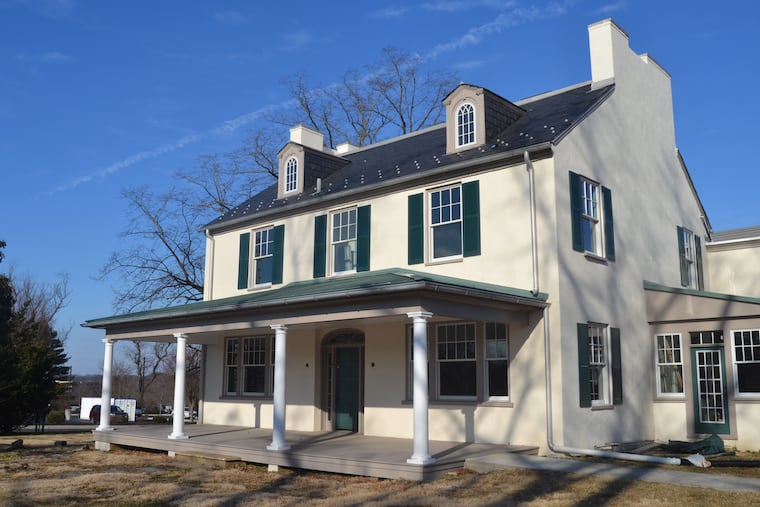Kennett Underground Railroad Center awarded $50K planning grant to rehab Fussell House
The Kennett Center is the only site in Pennsylvania to receive the grant this year.

Not that long ago, people in Chester County were petitioning Kennett Township officials to save the Fussell House from demolition by decay.
Also once known as “The Pines,” the Fussell House, owned by Bartholomew Fussell, a Quaker and a medical doctor, had been a “station” on the Underground Railroad.
Fussell and his family provided refuge for Black people escaping enslavement from just across state lines in Maryland or Delaware.
“He helped 2,000 slaves reach freedom,” the flyers urging preservation once said. “Now they’re tearing down his house.”
Today, there is positive news for the future of the house at 735 E. Baltimore Pike in Kennett Square.
The National Trust for Historic Preservation, through its African American Cultural Heritage Action Fund, is awarding a $50,000 grant to the Kennett Underground Railroad Center and the Brandywine Valley Scenic Byway Commission to support plans to use the Fussell House as an education center.
“History is crucial to our nation’s understanding of where we’ve come from, who we are today, and how we envision our future.
“As part of efforts to chart and preserve Underground Railroad routes, Kennett Township has partnered with the Kennett Underground Railroad Center to rehabilitate a historic property that once served as a “station” on formerly enslaved Africans’ journey to freedom,” the National Trust said Thursday.
The grant will support a comprehensive assessment, plan, and cost estimates to rehabilitate the house and also support educational programming.
“I’m stunned and shocked,” Crystal Crampton, director of the Kennett Underground Railroad Center, said Wednesday.
In its announcement, the National Trust said the Kennett center grant is part of a total of $3 million in grants going to protect and preserve 30 Black history sites around the country this year.
“The National Grant Program represents the Action Fund’s enduring commitment to telling the full American story — one that makes room for Black resilience, creativity, and achievement,” said Brent Leggs,executive director of the African American Cultural Heritage Action Fund.
“History is crucial to our nation’s understanding of where we’ve come from, who we are today, and how we envision our future. These grants will support critical preservation efforts to revitalize and sustain tangible links to our shared past that we hope will inspire future generations.”
Last year, two Philadelphia organizations, the Friends of the Tanner House and Zion Baptist Church, received grants from the Action Fund.
‘A hotbed’ of abolition
Currently, the Kennett Underground Railroad Center (KURC) leases a room inside the Kennett Heritage Center at 120 N. Union St.
Lynn Sinclair, founder of the heritage center, said that the township and Underground Railroad center have been discussing the idea of using the Fussell House as the center’s new headquarters.
Historical accounts describe the Brandywine Valley area as “a hotbed of abolitionist activity,” with dozens of houses that were Underground Railroad stations within an 8-mile radius of Kennett Square.
The Kennett Square abolitionists were Black and white, male and female, groups of religious organizations, and other groups who fed, sheltered, and helped Black people escaping toward freedom.
Three families on an Underground Railroad mission
The Fussell House was home to at least three medical doctors and three families of abolitionists who helped formerly enslaved people reach freedom.
The first medical doctor to live at the house was William H. Gillingham, who built the house in 1823 in the Federal architectural style. (Nearly a century later, in the 1900s, new owners altered the house to its current Colonial Revival style.)
In 1827, Bartholomew Fussell and his wife, Lydia, bought the property and lived there for about 10 years. Fussell, who was born in Chester County, moved to Maryland where he attended medical school at night and operated a school during the day.
Fussell (1794-1871) was not only known for his Underground Railroad work. In Maryland, he started a Sunday School where he taught enslaved African Americans to read and write.
After returning to Pennsylvania, he became a founding member of the American Anti-Slavery Association, and he championed medical education for women, hosting a meeting that led to the founding of Women’s Medical College of Pennsylvania in 1850.
In 1837, Fussell sold the house to Sumner Stebbins, another medical doctor. Sumner Stebbins had not only studied medicine under Fussell, but he was also a founding member of the American Anti-Slavery Society, formed in 1833. It is not surprising that Stebbins and his wife, Mary Ann Stebbins, continued Underground Railroad activities there.
By 1841, Chandler Darlington and his wife, Hannah Darlington, bought the house. They followed both Fussell and Stebbins in continuing to provide shelter for people seeking freedom from slavery.